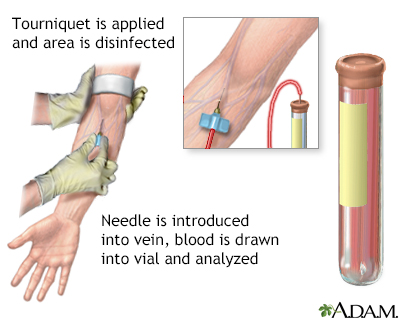Fibrin degradation products blood test
FDPs; FSPs; Fibrin split products; Fibrin breakdown products
Fibrin degradation products (FDPs) are the substances left behind when clots dissolve in the blood. A blood test can be done to measure these products.
Images

How the Test is Performed
A blood sample is needed.
How to Prepare for the Test
Certain medicines can change blood test results.
- Tell your health care provider about all the medicines you take.
- Your provider will tell you if you need to temporarily stop taking any medicines before you have this test. This includes blood thinners such as aspirin, heparin, and urokinase, which make it hard for the blood to clot.
- Do not stop or change your medicines without talking to your provider first.
How the Test will Feel
When the needle is inserted to draw blood, some people feel moderate pain. Others feel only a prick or stinging. Afterward, there may be some throbbing or slight bruising. This soon goes away.
Why the Test is Performed
This test is done to see if your clot-dissolving (fibrinolytic) system is working properly. Your provider may order this test if you have signs of disseminated intravascular coagulation (DIC) or another clot-dissolving disorder.
Normal Results
The result is normally less than 10 mcg/mL (10 mg/L).
Note: Normal value ranges may vary slightly among different labs. Some labs use different measurements or may test different specimens. Talk to your provider about the meaning of your specific test results.
What Abnormal Results Mean
Increased FDPs may be a sign of primary or secondary fibrinolysis (clot-dissolving activity) due to a variety of causes, including:
- Blood clotting problems
- Burns
- Problem with the heart's structure and function that is present at birth (congenital heart disease)
- Disseminated intravascular coagulation (DIC)
- Low level of oxygen in the blood
- Infections
- Leukemia
- Liver disease
- Problem during pregnancy such as preeclampsia, placenta abruption, miscarriage
- Recent blood transfusion
- Recent surgery that involved a heart and lung bypass pump, or surgery to lower high blood pressure in the liver
- Kidney disease
- Transplanted organ rejection
- Large blood clots inside the body
Risks
There is little risk involved with having your blood taken. Veins and arteries vary in size from one person to another, and from one side of the body to the other. Obtaining a blood sample from some people may be more difficult than from others.
Other risks with having blood drawn are slight, but may include:
- Excessive bleeding
- Fainting or feeling lightheaded
- Multiple punctures to locate veins
- Hematoma (blood accumulating under the skin)
- Infection (a slight risk any time the skin is broken)
Related Information
Fibrinogen blood testBlood clots
Antithrombin III blood test
Protein in diet
Fibrinolysis - primary or secondary
Placenta abruption - definition
Burns
Blue discoloration of the skin
Liver disease
Cirrhosis
Preeclampsia
Acute kidney failure
Septicemia
Transplant rejection
Hemolytic transfusion reaction
References
Levi M. Disseminated intravascular coagulation. In: Hoffman R, Benz EJ, Silberstein LE, et al, eds. Hematology: Basic Principles and Practice. 8th ed. Philadelphia, PA: Elsevier; 2023:chap 137.
Pai M, Moffat KA. Laboratory evaluation of hemostatic and thrombotic disorders. In: Hoffman R, Benz EJ, Silberstein LE, et al, eds. Hematology: Basic Principles and Practice. 8th ed. Philadelphia, PA: Elsevier; 2023:chap 127.
Sarode R, Kessler CM. Coagulation and fibrinolysis. In: McPherson RA, Pincus MR, eds. Henry's Clinical Diagnosis and Management by Laboratory Methods. 24th ed. Philadelphia, PA: Elsevier; 2022:chap 40.
Schafer AI. Approach to the patient with bleeding or thrombosis. In: Goldman L, Cooney KA, eds. Goldman-Cecil Medicine. 27th ed. Philadelphia, PA: Elsevier; 2024:chap 157.
BACK TO TOPReview Date: 2/3/2025
Reviewed By: Warren Brenner, MD, Oncologist, Lynn Cancer Institute, Boca Raton, FL. Review provided by VeriMed Healthcare Network. Also reviewed by David C. Dugdale, MD, Medical Director, Brenda Conaway, Editorial Director, and the A.D.A.M. Editorial team.

Health Content Provider
06/01/2028
|
A.D.A.M., Inc. is certified by URAC, for Health Content Provider (www.urac.org). URAC's certification program is an independent audit to verify that A.D.A.M. follows rigorous standards of quality and accountability. A.D.A.M. is among the first to achieve this important distinction for online health information and services. Learn more about A.D.A.M.'s editorial policy, editorial process and privacy policy. |
The information provided herein should not be used during any medical emergency or for the diagnosis or treatment of any medical condition. A licensed medical professional should be consulted for diagnosis and treatment of any and all medical conditions. Links to other sites are provided for information only -- they do not constitute endorsements of those other sites. © 1997- 2025 A.D.A.M., a business unit of Ebix, Inc. Any duplication or distribution of the information contained herein is strictly prohibited.
